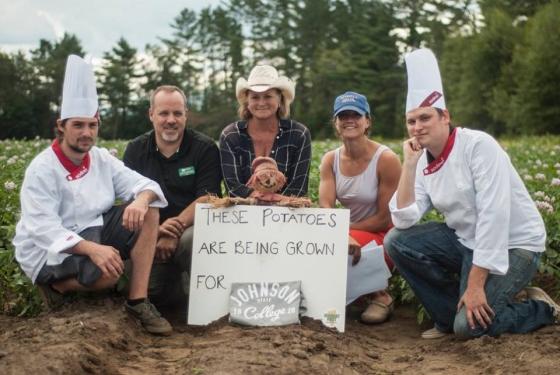Posted March 17, 2022 at 10:36am by Anonymous (not verified)
Farm to College

Strategies and Opportunities for Greater Local Food Procurement in Vermont Higher Education Food Service
Written by Jennie Porter
Institutions represent a unique opportunity in Vermont to increase access to local foods because they serve many meals a day to a wide range of people, and they can help to increase consumer awareness of the benefits of eating locally produced foods. As such, the institutional consumption goal of Vermont’s Farm to Plate food system plan calls for increasing the amount of local food served in institutions. Vermont colleges and universities spend approximately $16.5 million on food annually. According to the Farm to Institution New England 2015 Farm to College Survey, approximately 31 percent of Vermont college and university food spending ($5.1 million) is spent on local food.
To further address the institutional consumption goal, the Farm to Plate Network’s Farm to Institution Task Force prepared and released Opportunities and Barriers to Greater Local Food Procurement in Vermont Higher Education Food Service. The report provides recommendations for food service personnel and technical assistance providers to increase local food purchasing at colleges and universities across the state.
Institutions across the New England region are striving to increase local food purchasing and some have documented which strategies have been most successful in this endeavor. In order to draw upon the existing wealth of knowledge in farm to college efforts and compare to what is taking place in Vermont, the task force hired Dr. David Conner of the University of Vermont to analyze successful local food procurement practices documented by the University of Massachusetts, the University of Maine, School Food FOCUS, and Farm to Institution New England (FINE). Dr. Conner conducted interviews with 13 of the 21 higher education food service operations in Vermont, representing a variety of operation sizes, locations, and management structures. Dr. Conner’s analysis identified the successful strategies Vermont institutions are already employing and which strategies may present opportunities to increase local food procurement.
Below is a summary of the successful practices Dr. Conner found to be most widely employed in Vermont, the barriers Vermont institutions still face in procuring more local food, and the strategies that present the greatest opportunity for doing so.
What is working well?
The following is a list of successful strategies that are already being widely utilized by Vermont colleges and universities, contributing to the approximately $5.1 million they collectively spend on local food annually:
● Quantitatively measuring and reporting local food purchases;
● Engaging both internal and external stakeholders to build trust and transparency;
● Promoting local foods in marketing efforts;
● Hosting special events that feature local food vendors;
● Mobilize dining staff to communicate the story of local foods to consumers.
What are barriers to greater local food procurement?
While Vermont colleges and universities report spending between 14-40% of their food budgets on local food, they still face challenges in increasing the amount of local food they purchase. The following challenges were commonly cited as making local food difficult to use or procure:
● The inability to know which ingredients are local all of the time, especially at larger institutions with multiple dining locations;
● Inconsistent quantity and quality of local products;
● The higher price of local foods, and particularly local proteins;
● The lack of lightly processed local produce available;
● Poor communication with local vendors that sometimes results in shortages or false claims;
● The heavy reliance on one distributor in the state for local foods.
Where are the opportunities?
The following list of strategies for food service operators and technical assistance providers was developed based on best practices gleaned from the literature and reported through interviews with the Vermont institutions. Widespread utilization of these strategies represent the greatest opportunity for Vermont colleges and universities to increase local food purchasing.
● Develop better mechanisms for real time information/labeling of what is local;
● Host “speed dating” sessions to facilitate vendor/buyer relationships;
● Share menus with other institutions and distributors to spread and encourage more local sourcing;
● Utilize local product specials from distributors;
● Provide 100% of a select item from local sources, whenever possible, to more easily communicate the story with consumers;
● Facilitate advance planning with producers to maintain steady product flow;
● Incorporate local foods into catering and retail outlets, which have more price flexibility and can help subsidize other local purchases;
● Check-in with vendors regularly to ensure the relationship is meeting the needs of both parties.
The Farm to Institution Task Force intentionally drew from the collective wisdom of the region to recommend a set of best practices that colleges and universities can follow to overcome barriers they face in using and procuring local food and the task force encourages campuses across the state to consider and adopt the best practices that make sense for their own unique operations.
